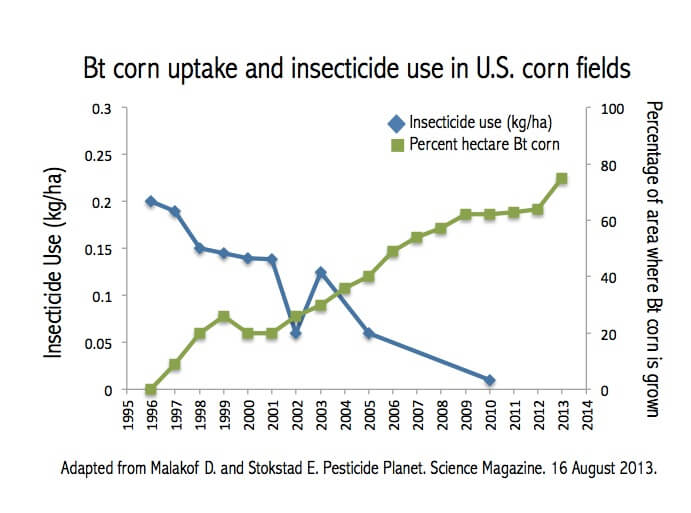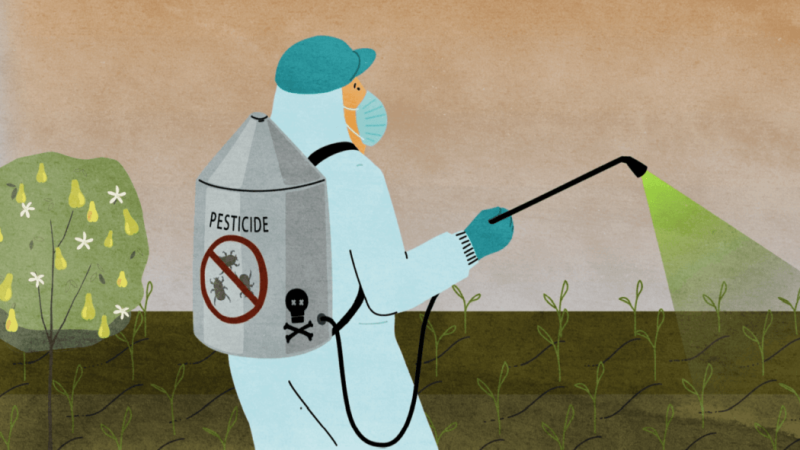“For decades, conventional farmers have been trapped on a ‘pesticide treadmill,'” the Pesticide Action Network (PAN) alleges. “Patented GE seeds are designed for use with specific pesticides, leading to increased use of these chemicals. And widespread application of these pesticides leads to the emergence of herbicide-resistant “superweeds …”
Scientists have amassed a mountain of evidence on the environmental impacts of GE crop cultivation. In light of this research, have the activist predictions held up? According to a just-published review, it’s time for the folks at PAN to find new jobs—because they sure can’t forecast the future.
Economist Graham Brookes surveyed the existing peer-reviewed literature, then analyzed “crop and country-specific farm-level changes in husbandry, pest and weed control practices, and pesticide usage data.” Conclusion? Between 1996 and 2020,
… [T]he widespread use of GM insect resistant and herbicide tolerant seed technology has reduced pesticide application by 748.6 million kg (−7.2%) of active ingredient and, as a result, decreased the environmental impact associated with insecticide and herbicide use on these crops …
These results yet again confirm that environmental groups don’t understand the technologies they oppose. A nuanced analysis requires that we account for the risks and benefits of employing pesticides. PAN and their allies exaggerate the former while ignoring the latter, which is why they consistently get the wrong answer.

Not-so-super “superweeds”
Herbicide-resistant weeds pose a real threat to agricultural productivity, as PAN correctly explained. An estimated 56 weed species have developed glyphosate resistance, 17 of which have been found in the US. Nobody denies that some growers became too dependent on the weedkiller. But, as Brookes told ACSH by email, “two words are highly relevant here – ‘context’ and ‘relative.’”
Like all living organisms, weeds adapt to their environments; they can often thrive in unfavorable conditions, spread great distances and develop resistance to herbicides after repeated exposure. This isn’t an industry-created problem—it’s evolution. All farmers, no matter the production system they utilize, battle robust weeds.
The good news is that growers, weed scientists, and pesticide manufacturers are rational actors with an incentive to address the problem. Activist groups tend to assume that farmers use a chemistry until it stops working, which prompts the companies to develop a new herbicide, which farmers use until it stops working—wash, rinse, repeat. But this isn’t the case. According to Brookes:
Where farmers using GM HT [genetically modified, herbicide-tolerant] crop technology have been, and are, faced with weeds resistant to glyphosate, they are advised to be proactive and include other herbicides (with different and complementary modes of action) in combination with glyphosate and in some cases to adopt cultural practices such as plowing in their integrated weed management systems.
We know that growers have adjusted their weed management practices based on this advice because of documented changes in herbicide usage patterns. Farmers routinely use different herbicides from season to season, for example, or “tank mix” different chemistries with unique modes of action. Both practices reduce the likelihood that weeds will evolve resistance to any one herbicide. Combined with other strategies, Brookes noted that these changes in weedkiller use
… reflect the broader agenda of developing more integrated weed control strategies across all forms of cropping systems … to minimize and slowdown the potential for weeds developing resistance to whatever form of weed control is practiced.
Here’s just one data point that lends support to this conclusion. In the last six years or so, glyphosate use has increased at a slower rate compared to the use of other herbicides. As Brookes put it, in 2016, “glyphosate accounted for a lower share of total active ingredient use on the GM HT crop (63%) than in 1998 when it accounted for 82% of total active ingredient use.” This trend continued in 2020
… with the availability of additional options for weed control via varieties with GM HT tolerance to other herbicides. Almost all of the new GM HT seed technology used is tolerant to glyphosate and other herbicides rather than being tolerant only to other herbicides.
Researchers are also developing more low-toxic chemistries that weeds will have a difficult time overcoming. PAN and other anti-pesticide groups almost universally oppose the introduction of these novel products. It’s an odd stance for them to take if you think about it. Using a variety of herbicides helps mitigate weed evolution, yet the activists who complain about “superweeds” don’t want these tools on the market. You could be forgiven for thinking that they don’t really want to solve the problems they complain about.

Conclusion
When we zoom out and consider a few other variables, the activist narrative undeniably implodes. Recent research has also shown that cultivating GE crops cut agricultural CO2 emissions by 23,631 million kilograms and boosted farm income by $261.3 billion over the same 1996 to 2020 period.

The significance here can’t be overstated: profitable growing practices help protect our planet. The depiction of “industrial agriculture” as a greedy, short-sighted enterprise with no regard for sustainability is an environmentalist myth. Are farmers and pesticide companies selfless angels? Of course not; they want to make as much money as possible. But attaining that end requires the judicious use of chemical pesticides and other inputs.
Shocking as it may seem to some observers, farmers understand this economic reality far better than progressive activists with an ax to grind.
Cameron J. English is the director of bio-sciences at the American Council on Science and Health. Visit his website and follow ACSH on Twitter @ACSHorg
A version of this article was originally posted at the American Council on Science and Health and is reposted here with permission. The Cornell Alliance for Science can be found on Twitter @ACSHorg































